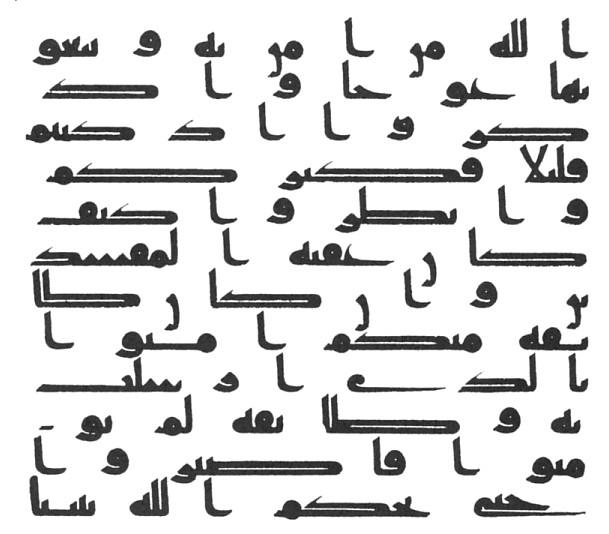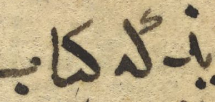|
Balochi Standard Alphabet
The Balochi Standard Alphabet ( bal, بلۏچی استانداردݔن اب),(Romanized: Balòci Estàndàrdèn Ab) is a writing system used for the Balochi language spoken in Balochistan, a region spanning parts of Pakistan, Afghanistan and Iran. This writing system is derived from the Persian alphabet, itself derived from the Arabic script. Alphabet The Balochi alphabet, standardized by Balochi Academy Sarbaz, consists of 32 letters. Script Correspondence Table Some diagraphs in Balochi writing Balochi also have 3 diagraphs set by Balchi Academy sarbaz in Standard Alphabets. Arabic diacritics in Balochi writing Arabic diacritics are used in Balochi, as with other scripts derived from Arabic: Notes Some dialects of Balochi very infrequently use the voiced retroflex flap, meaning ڑ. Due to its immense rarity in Balochi, most orthographies of the language leave out glyphs for the phoneme. When written however, it is usually represented with ر. This alphabet uses ... [...More Info...] [...Related Items...] OR: [Wikipedia] [Google] [Baidu] |
Writing System
A writing system is a method of visually representing verbal communication, based on a script and a set of rules regulating its use. While both writing and speech are useful in conveying messages, writing differs in also being a reliable form of information storage and transfer. Writing systems require shared understanding between writers and readers of the meaning behind the sets of characters that make up a script. Writing is usually recorded onto a durable medium, such as paper or electronic storage, although non-durable methods may also be used, such as writing on a computer display, on a blackboard, in sand, or by skywriting. Reading a text can be accomplished purely in the mind as an internal process, or expressed orally. Writing systems can be placed into broad categories such as alphabets, syllabaries, or logographies, although any particular system may have attributes of more than one category. In the alphabetic category, a standard set of letters represent speech ... [...More Info...] [...Related Items...] OR: [Wikipedia] [Google] [Baidu] |
International Phonetic Alphabet
The International Phonetic Alphabet (IPA) is an alphabetic system of phonetic transcription, phonetic notation based primarily on the Latin script. It was devised by the International Phonetic Association in the late 19th century as a standardized representation of speech sounds in written form.International Phonetic Association (IPA), ''Handbook''. The IPA is used by lexicography, lexicographers, foreign language students and teachers, linguistics, linguists, speech–language pathology, speech–language pathologists, singers, actors, constructed language creators, and translators. The IPA is designed to represent those qualities of speech that are part of wiktionary:lexical, lexical (and, to a limited extent, prosodic) sounds in oral language: phone (phonetics), phones, phonemes, Intonation (linguistics), intonation, and the separation of words and syllables. To represent additional qualities of speech—such as tooth wiktionary:gnash, gnashing, lisping, and sounds made wi ... [...More Info...] [...Related Items...] OR: [Wikipedia] [Google] [Baidu] |
Bari Ye
Bari ( , ; nap, label= Barese, Bare ; lat, Barium) is the capital city of the Metropolitan City of Bari and of the Apulia region, on the Adriatic Sea, southern Italy. It is the second most important economic centre of mainland Southern Italy after Naples. It is a port and university city, as well as the city of Saint Nicholas. The city itself has a population of 315,284 inhabitants, over , while the urban area has 750,000 inhabitants. The metropolitan area has 1.3 million inhabitants. Bari is made up of four different urban sections. To the north is the closely built old town on the peninsula between two modern harbours, with the Basilica of Saint Nicholas, the Cathedral of San Sabino (1035–1171) and the Hohenstaufen Castle built for Frederick II, which is now also a major nightlife district. To the south is the Murat quarter (erected by Joachim Murat), the modern heart of the city, which is laid out on a rectangular grid-plan with a promenade on the sea and the ... [...More Info...] [...Related Items...] OR: [Wikipedia] [Google] [Baidu] |
Close Front Unrounded Vowel
The close front unrounded vowel, or high front unrounded vowel, is a type of vowel sound that occurs in most spoken languages, represented in the International Phonetic Alphabet by the symbol i. It is similar to the vowel sound in the English word ''meet''—and often called long-e in American English. Although in English this sound has additional length (usually being represented as ) and is not normally pronounced as a pure vowel (it is a slight diphthong), some dialects have been reported to pronounce the phoneme as a pure sound. A pure sound is also heard in many other languages, such as French, in words like ''chic''. The close front unrounded vowel is the vocalic equivalent of the palatal approximant . They alternate with each other in certain languages, such as French, and in the diphthongs of some languages, with the non-syllabic diacritic and are used in different transcription systems to represent the same sound. Languages that use the Latin script commonly us ... [...More Info...] [...Related Items...] OR: [Wikipedia] [Google] [Baidu] |
Voiced Retroflex Flap
The voiced retroflex flap is a type of consonantal sound, used in some spoken languages. The symbol in the International Phonetic Alphabet that represents this sound is , and the equivalent X-SAMPA symbol is r`. Features Features of the voiced retroflex flap: Occurrence See also * Index of phonetics articles A * Acoustic phonetics * Active articulator * Affricate * Airstream mechanism * Alexander John Ellis * Alexander Melville Bell * Alfred C. Gimson * Allophone * Alveolar approximant () * Alveolar click () * Alveolar consonant * Alveolar ejecti ... Notes References * * * * * * * * * * * * * * External links * {{LetterR Retroflex consonants Tap and flap consonants Pulmonic consonants Oral consonants Central consonants ... [...More Info...] [...Related Items...] OR: [Wikipedia] [Google] [Baidu] |
Nasal Vowel
A nasal vowel is a vowel that is produced with a lowering of the soft palate (or velum) so that the air flow escapes through the nose and the mouth simultaneously, as in the French vowel or Amoy []. By contrast, oral vowels are produced without nasalization. Nasalized vowels are vowels under the influence of neighbouring sounds. For instance, the [] of the word ''hand'' is affected by the following nasal consonant. In most languages, vowels adjacent to nasal consonants are produced partially or fully with a lowered velum in a natural process of assimilation and are therefore technically nasal, but few speakers would notice. That is the case in English: vowels preceding nasal consonants are nasalized, but there is no phonemic distinction between nasal and oral vowels, and all vowels are considered phonemically oral. The nasality of nasal vowels, however, is a distinctive feature of certain languages. In other words, a language may contrast oral vowels and nasalized vowels ... [...More Info...] [...Related Items...] OR: [Wikipedia] [Google] [Baidu] |
Gemination
In phonetics and phonology, gemination (), or consonant lengthening (from Latin 'doubling', itself from ''gemini'' 'twins'), is an articulation of a consonant for a longer period of time than that of a singleton consonant. It is distinct from stress. Gemination is represented in many writing systems by a doubled letter and is often perceived as a doubling of the consonant.William Ham, ''Phonetic and Phonological Aspects of Geminate Timing'', p. 1-18 Some phonological theories use "doubling" as a synonym for gemination, others describe two distinct phenomena. Consonant length is a distinctive feature in certain languages, such as Arabic, Berber, Danish, Estonian, Hindi, Hungarian, Italian, Japanese, Kannada, Punjabi, Polish and Turkish. Other languages, such as English, do not have word-internal phonemic consonant geminates. Consonant gemination and vowel length are independent in languages like Arabic, Japanese, Finnish and Estonian; however, in languages like Italian, No ... [...More Info...] [...Related Items...] OR: [Wikipedia] [Google] [Baidu] |
Shadda
Shaddah ( ar, شَدّة ' , "[sign of] emphasis", also called by the verbal noun from the same root, tashdid ' "emphasis") is one of the Arabic diacritics, diacritics used with the Arabic alphabet, indicating a gemination, geminated consonant. It is functionally equivalent to writing a consonant twice in the orthographies of languages like Latin, Italian language, Italian, Swedish language, Swedish, and Ancient Greek, and is thus rendered in Latin script in most schemes of Arabic transliteration, e.g. = ' 'pomegranates'. Form In shape, it is a small letter ''shin (letter)#Arabic šīn/sīn, s(h)in'', standing for ''shaddah''. It was devised for poetry by al-Khalil ibn Ahmad in the eighth century, replacing an earlier dot.Versteegh, 1997. ''The Arabic language''. p 56. Combination with other diacritics When a is used on a consonant which also takes a Arabic diacritics#Fatḥah, , the is written above the . If the consonant takes a Arabic diacritics#Kasrah, , it is wr ... [...More Info...] [...Related Items...] OR: [Wikipedia] [Google] [Baidu] |
ḍammah
The Arabic script has numerous diacritics, which include: consonant pointing known as (), and supplementary diacritics known as (). The latter include the vowel marks termed (; singular: , '). The Arabic script is a modified abjad, where short consonants and long vowels are represented by letters but short vowels and consonant length are not generally indicated in writing. ' is optional to represent missing vowels and consonant length. Modern Arabic is always written with the ''i‘jām''—consonant pointing, but only religious texts, children's books and works for learners are written with the full ''tashkīl''—vowel guides and consonant length. It is however not uncommon for authors to add diacritics to a word or letter when the grammatical case or the meaning is deemed otherwise ambiguous. In addition, classical works and historic documents rendered to the general public are often rendered with the full ''tashkīl'', to compensate for the gap in understanding resulting ... [...More Info...] [...Related Items...] OR: [Wikipedia] [Google] [Baidu] |
Kasrah
The Arabic script has numerous diacritics, which include: consonant pointing known as (), and supplementary diacritics known as (). The latter include the vowel marks termed (; singular: , '). The Arabic script is a modified abjad, where short consonants and long vowels are represented by letters but short vowels and consonant length are not generally indicated in writing. ' is optional to represent missing vowels and consonant length. Modern Arabic is always written with the ''i‘jām''—consonant pointing, but only religious texts, children's books and works for learners are written with the full ''tashkīl''—vowel guides and consonant length. It is however not uncommon for authors to add diacritics to a word or letter when the grammatical case or the meaning is deemed otherwise ambiguous. In addition, classical works and historic documents rendered to the general public are often rendered with the full ''tashkīl'', to compensate for the gap in understanding resulting ... [...More Info...] [...Related Items...] OR: [Wikipedia] [Google] [Baidu] |
Fatḥah
The Arabic script has numerous diacritics, which include: consonant pointing known as (), and supplementary diacritics known as (). The latter include the vowel marks termed (; singular: , '). The Arabic script is a modified abjad, where short consonants and long vowels are represented by letters but short vowels and consonant length are not generally indicated in writing. ' is optional to represent missing vowels and consonant length. Modern Arabic is always written with the ''i‘jām''—consonant pointing, but only religious texts, children's books and works for learners are written with the full ''tashkīl''—vowel guides and consonant length. It is however not uncommon for authors to add diacritics to a word or letter when the grammatical case or the meaning is deemed otherwise ambiguous. In addition, classical works and historic documents rendered to the general public are often rendered with the full ''tashkīl'', to compensate for the gap in understanding resulting ... [...More Info...] [...Related Items...] OR: [Wikipedia] [Google] [Baidu] |



_-_2_-_Qur'anic_verses.jpg)


